

Minecraft in Education. Minecraft in Education: 30 ideas for using Minecraft in the classroom It is well documented how using games in a classroom context can facilitate collaborative learning, promote problem solving and stimulate an engaging learning environment.

One methodology that demonstrates all these elements is Game Based Learning. What is Games Based Learning? Classroom Gaming: What It Isn't, What It Is, and How to Do It Right. In his TED Talk exactly six years ago, American video game designer Jesse Schell predicted a future in which games would rule everyday life.

The government would hand out experience points—aka tax relief—for making “right” decisions, such as paying off your credit card bill or saving more in your retirement fund. Companies, too, would use gamification to collect data and reward you based on what you buy, eat, and even how long you brush your teeth. Well, the future has arrived—at least in China. Using a unique database of consumer information, a gamified social credit system compiles individual social credit scores. Introduced in a government-approved pilot project from the world's biggest online shopping platform, it’s said to be a test-drive of sorts for a similar program that will be mandatory for all Chinese citizens by 2020.
Although this may seem drastic to many Americans, we believe everyday gaming is here to stay. 15 Incredible Architectural Feats Made in Minecraft. With more than 70 million copies sold worldwide, it would be unfair to refer to Minecraft as just a simple game of textured boxes in a pixelated 3D world.
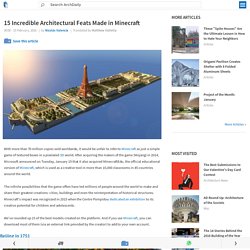
After acquiring the makers of the game (Mojang) in 2014, Microsoft announced on Tuesday, January 19 that it also acquired MinecraftEdu, the official educational version of Minecraft, which is used as a creative tool in more than 10,000 classrooms in 45 countries around the world. The infinite possibilities that the game offers have led millions of people around the world to make and share their greatest creations: cities, buildings and even the reinterpretation of historical structures.
Minecraft's impact was recognized in 2015 when the Centre Pompidou dedicated an exhibition to its creative potential for children and adolescents. We've rounded up 15 of the best models created on the platform. And if you use Minecraft, you can download most of them (via an external link provided by the creator) to add to your own account. Everything You Need to Know About 'Minecraft' - GeekDad®
By Caroline Knorr, Common Sense Media If your kid has been swept up in the Minecraft craze, you’ve probably come to realize that resistance is futile.
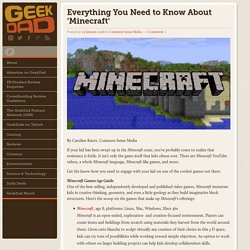
It isn’t only the game itself that kids obsess over. There are Minecraft YouTube videos, a whole Minecraft language, Minecraft-like games, and more. Get the know-how you need to engage with your kid on one of the coolest games out there. KQED Public Media for Northern CA. 6 Killer Examples Of Gamification In eLearning. For the Hesitant Teacher: Leveraging the Power of Minecraft. If there’s any video game that has successfully made its way into the classroom, it’s Minecraft.
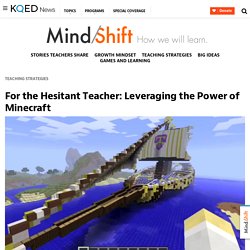
There’s a small subset of teachers using all kinds of digital games in interesting ways, but the blockbuster hit Minecraft and its educational counterpart MinecraftEDU have reached much wider audiences. But getting started with MinecraftEDU can be intimidating for teachers who don’t consider themselves “gamers” and aren’t sure how to harness the engagement and excitement of Minecraft. Luckily, there’s a robust and global Minecraft teacher community to supply tips, support and even lesson plans. Teachers who already use Minecraft in the classroom love it because of the flexibility it offers — almost any subject can be taught with a little creativity. Zimmer and other experienced Minecraft teachers say it’s important to manage expectations when using Minecraft in the classroom. Each vignettes tells a loose story about some aspect of Dark Ages history. Minecraft in education. How Minecraft and Duct Tape Wallets Prepare Our Kids for Jobs That Don’t Exist Yet.
EdSurge Newsletters Receive weekly emails on edtech products, companies, and events that matter.
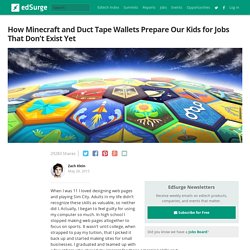
When I was 11 I loved designing web pages and playing Sim City. Adults in my life didn’t recognize these skills as valuable, so neither did I. Actually, I began to feel guilty for using my computer so much. In high school I stopped making web pages altogether to focus on sports. So, now I’m building DIY, the online community I wish I had when I was young. My objective with this wide-ranging set of skills, and involving the community so closely in their development, is to give kids the chance to practice whatever makes them passionate now and feel encouraged –– even if they’re obsessed with making stuff exclusively with duct tape. How I replaced Blackboard with 3D Gamelab « Dr. Ray Pastore's Instructional Technology Blog. In today’s college classroom the LMS is commonly used to manage, track, and facilitate the learning process for both face to face and online learning courses.

Most colleges currently run the Blackboard LMS, which is a very good LMS that is designed to meet the needs of today’s faculty. However, I personally have found Blackboard to be a bit dull because it’s used so often and I love to experiment with new things. So I learned about a new LMS called 3D Gamelab which was designed to function like a gamified LMS. Minecraft. Minecraft in school? How video games could be the future of learning. Math, geography, art, design – these are just some of the things that children can learn from the popular video game Minecraft, a new study shows.
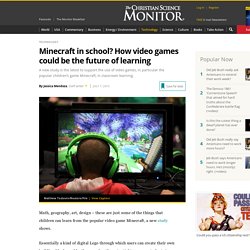
Essentially a kind of digital Lego through which users can create their own building-block worlds, the game has the potential to engage students in problem-solving, research, creative thinking, and even social interaction, say the Australia-based researchers. Their findings add to a growing body of research supporting not only the use of video games in classroom learning, but also the idea that learning is less an exercise in one-time memorization than an exciting, continuous experience. “We've seen some real success with engagement, problem solving… with design and their creative work,” Michael Dezuanni, assistant professor at Australia’s Queensland University of Technology and the study’s co-author, told the Australian Broadcasting Corporation. Video game learning is not a new idea. Microsoft Is Launching A Portal For Teachers To Use Minecraft In The Classroom.
Microsoft and Mojang are launching a portal where teachers can share ideas about how to incorporate Minecraft into the classroom.
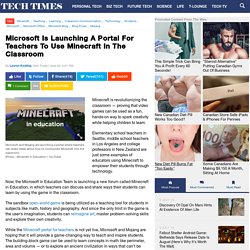
(Photo : Minecraft in Education | YouTube) Minecraft is revolutionizing the classroom — proving that video games can be used as a fun, hands-on way to spark creativity while helping children to learn. Elementary school teachers in Seattle, middle school teachers in Los Angeles and college professors in New Zealand are just some examples of educators using Minecraft to empower their students through technology. Now, the Microsoft in Education Team is launching a new forum called Minecraft in Education, in which teachers can discuss and share ways their students can learn by using the game in the classroom. The sandbox open-world game is being utilized as a teaching tool for students in subjects like math, history and geography. (Photo : Minecraft in Education | YouTube) Via: Microsoft. Minecraft: Researchers urge teachers to embrace game as tool to teach maths, art, geography.
Updated Teachers should use the hugely popular children's digital game Minecraft to help teach maths, design, art and geography, research from the Queensland University of Technology (QUT) shows.
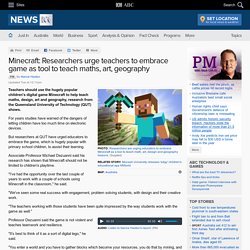
For years studies have warned of the dangers of letting children have too much time on electronic devices. 50 Of The Best Video Games For Learning In 2015. 50 Of The Best Video Games For Learning in 2015 by TeachThought Staff We’ve discussed the merits and utility of video games in the classroom before, so we won’t beleaguer the point. If you’re interested in the possibility of video games for learning–that is, teaching and learning with video games to master both academic and non-academic content–than the following collection may be of interest to you. We’ve discussed before the logistics of how to teach with video games (especially for non-mobile games). What exactly this looks like on a daily basis in your classroom depends on the reality of your classroom: Available technology, WiFi access and bandwidth, grade level, content area, your comfort level with games, and so on.
Minecraft Guide: Getting Started with Minecraft. Minecraft is one of the bestselling video games of all time but getting started with it can be a bit intimidating, let alone even understanding why it’s so popular. In this edition of How-To Geek School we’re going to help you get started with the game (or at least understand why your kids love it so much). Despite its simple appearance there is a whole lot going on in Minecraft. It can feel confusing but don’t worry, we’ve laid out a series of lessons that will take you from not knowing a single thing about the game to advanced gameplay. This includes creating custom maps, building in-game devices and structures, as well as thriving in the difficult Survival Mode.
ROBLOX.com. 10 Things to Start with in Google Classroom. In a nut shell, Google Classroom is Google Drive Management. It allows you to assign assignments and collect work from students. If you are just starting off with Google Classroom here are some things you will want to try first: When you first login you will be asked if you are a student or a teacher. It is very important that you indicate that you are a teacher. If you make a mistake, you will need to contact your Google Apps administrator at your site to reset your status. Click on the plus button in the upper right to create a class for your students to join. Entering the Google Classroom class takes you to the class stream. Engaging Instructional Design & Gamification. According to a survey, 75% of people are gamers, half play sometimes and a little more than a quarter play as often as moderate to fair amount of the time.
Another study found that 5 million people in the U.S. spend more than 40 hours a week. Many of these are games are accessed through the Internet and feature a social aspect that connects players to friends, family, and other participants, making them even more addictive. The conductor of the survey also found that about 80% of users said they’d be more productive at work or school if the work they were involved in was more game-like. Gaming Design For Elearning. In my last post, The Anatomy of Good Gamified eLearning, I made the suggestion that there are sound instructional principles underlying gaming design in eLearning.
For one, we know that playing games motivate and engage players with challenges, feedback about how they are doing, and progression i.e. reaching the next level of skill. UX Designers Can Learn From Game Design and Gamification. A long time ago, a post published at Smashing Magazine titled “What Web Designers Can Learn From Video Games” (see resources) opened my eyes about important and relevant reflections regarding the lessons that web designers could learn from video games. The article put video games into the level of game design and game design thinking, splitting the game into game elements and understanding the application of them into design of web interactions. MinecraftEdu Takes Hold in Schools.